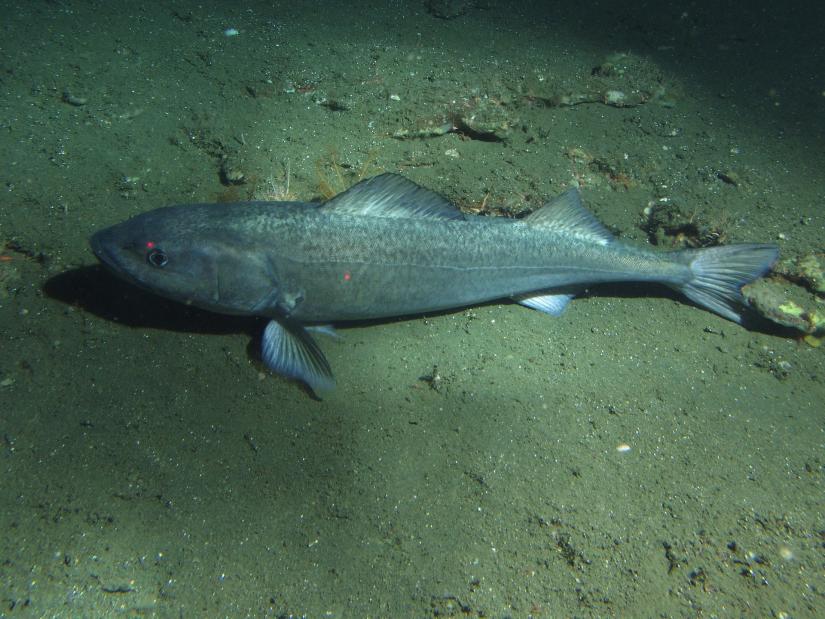Sablefish (Black cod)
Anoplopoma fimbria
The Science
THE SCIENCE
Although commonly called “black cod”, this fish is not actually in the cod family, it is one of only two species in its own family!

Taxonomic description
- Also known as black cod or butterfish. [2]
- Superficially resembles members of the cod family (Gadidae), but is not related. [9]
- Long and is dark gray to black on the upper half of its body, lighter gray on the lower half. [1]
- Has separate dorsal fins; these are used to tell it apart from its relative skilfish. [1]
- Can grow up to 1 m (3 ft) and weigh up to 25 kg (55 lb).
Distribution
- Found along the northeastern Pacific Ocean from northern Mexico to Alaska, but is most commonly found in Alaska. [1]
- There are two populations in eastern Pacific, Northern and Southern. [2]
- Found in the western north Pacific.
Life history
- Is a long-lived species, and 40 year old individuals are commonly caught.
- Some individuals are known to live 90 years or more. [2]
- Reproduces from March – April in Alaska; January – March in California to British Columbia. [2]
- Spawning and early egg development occurs in deeper water.
- Hatched larvae swim to surface waters to feed on small zooplankton.
- Juveniles remain inshore until 2 years of age and begin to migrate to deeper water.
- Sablefish is fully mature around ages 5-7 years. [1]
Habitat
- This fish lives on the ocean bottom at depths 200 m (650) feet and deeper.
- Some found down to 3000 m (9800 ft). [2]
- Smaller juvenile fish live near the surface close to the coast.
The Fishery
THE FISHERY
While only recently gaining popularity, sablefish has been harvested by U.S. and Canadian fishermen since the late 1800’s.

Seasonal availability
- Year-round with lower catch limits during the winter months (spawning season). [3]
Regulatory and managing authority
- Managed federally by the NOAA fisheries and, as established by the Magnuson-Stevens Act, the Pacific Fishery Management Council (PFMC) through the Pacific Coast Groundfish Fishery Management Plan (FMP). [2,4]
- As established by the Marine Life Management Act, the California Fish and Game Commission (CFGC) regulates the fishery in state waters, and the California Department of Fish and Wildlife (CDFW) manages this fishery. [12]
- The California Groundfish Collective combines input from the industry and government entities to inform regulatory and management measures for this fishery. [13]
Gear type
- Primarily caught by fixed gear (baited longlines & baited traps) [2,6], where traps are submerged ~0.5 mile deep and emptied after 3-4 days. [5]
- Occasionally caught with bottom trawls [6], which are used for various deepwater species. [2]
Status of the fishery
- NMFS Fish Stock Sustainability Index classifies the stock as a “4” out of 4, reflecting that the stock has known status, is not overfished or subject to overfishing, and maintains a biomass at or above maximum sustainable yield. [2]
- Classified as a “Good Alternative” by Monterey Bay Aquarium’s “Fish Watch” (would be “Best Choice” if ranked using only fixed gear, not trawling). [7]
Potential ecosystem impacts
- Impacts of commercial fishing efforts on sablefish habitat are minimal & temporary. [2]
- Bottom trawls often catch unintended species, however many of these species are also collected for human consumption. [2]
- Bycatch is reduced across all gear types through catch reporting per the West Coast Groundfish Trawl Catch Share Program.
The Seafood
THE SEAFOOD
Because of its high oil content, sablefish is great smoked or as dips and fillings!

Edible portions
- Sold headed and gutted, as fillets or steaks.

Description of meat
- Commonly known as the “butterfish” because of its rich, mild flavor and velvety texture. [2,9]
- The meat consists of large, delicate flakes that melt in your mouth.
Culinary uses
- To fillet, check out eHow.com. [10]
- Common preparations include baked, broiled, grilled, sautéed, smoked, steamed, and as sushi.
- The fat makes it difficult to overcook the fish.
- Key Preparation Note: Sablefish has large pin bones that run along the center, so make sure to remove these before preparing.
- Recipes for sablefish can be found at Yummly. [11]
Nutritional information
- Cooked dry heat, ½ fillet (5.3 oz). [8]
- High in omega-3 fatty acids. [8]
Toxicity report
- There are no known contaminants.
Seasonal availability
- Available year-round in San Diego.
References
[1] ADGF. Alaska Department of Fish and Game. n.d. Sablefish. Web. http://www.adfg.alaska.gov/index.cfm?adfg=sablefish.main. Accessed 10 Sept 2020.
[2] NOAA Fish Watch. 2020. Fish Watch and Seafood Profiles. Sablefish. Web. https://www.fishwatch.gov/profiles/sablefish. Accessed 10 Sept 2020.
[3] California Department of Fish and Wildlife. n.d. Final California Commercial Landings. Web. https://wildlife.ca.gov/Fishing/Commercial/Landings#260042586-2019. Accessed 10 Sept 2020.
[4] Pacific Fishery Management Council. 2020. Sablefish area management and trawl allocation attainment (including gear switching). Web. https://www.pcouncil.org/actions/groundfish-fmp-amendment-gear-switching-and-sablefish-area-management/. Accessed 10 Sept 2020.
[5] "About Philip Harris." Sea Nag. Blogger. 2011. Web. http://www.seanag.com/2011/08/about-philip-harris.html. 29 July 2013.
[6] McKnight, C. and R. Leos. 2008. Sablefish, Anoplopoma fimbria. 2008 Status of the Fisheries. California Dept of Fish & Wildlife, Web. https://nrm.dfg.ca.gov/FileHandler.ashx?DocumentID=34442&inline. 26 July 2013.
[7] Seafood Watch Consulting Researcher. 2014. Groundfish, California Groundfish Collective. Web. https://www.seafoodwatch.org/-/m/sfw/pdf/reports/g/mba_seafoodwatch_california_groundfish_collective_fishery_report.pdf. Accessed 10 Sept 2020.
[8] SELF nutrition data. 2013. “Fish, sablefish, cooked, dry heat”. http://nutritiondata.self.com/facts/finfish-and-shellfish-products/4230…
[9] ThisFish. n.d. Sablefish (Black Cod). Web. http://thisfish.info/fishery/species/sablefish/. Accessed 10 Sept 2020.
[10] eHow food. 2013. How to fillet sablefish. www.ehow.com/how_8652544_fillet-sablefish.html
[11] “Black Cod Sablefish Recipes.” Yummly. www.yummly.com/recipes/black-cod-sablefish
[12] Marine Life Management Act. n.d. California Department of Fish and Wildlife. Web. https://wildlife.ca.gov/Conservation/Marine/MLMA. Accessed 24 August 2020.
[13] The Nature Conservancy. 2015. The California Groundfish Collective. Web. http://www.cagroundfish.org/#our-story. Accessed 2 December 2020.
[14] NOAA. flickr. 2005. sanc1716. Digital image. Web. https://flickr.com/photos/noaaphotolib/5020500126. Accessed 24 February 2021.
[15] Tuna Harbor Dockside Market. Facebook. 2019. Digital image. Web. https://www.facebook.com/thdocksidemarket/photos/2307212002641403. Accessed 24 February 2021.
[16] Jansen, M. flickr. 2010. 20100612_Jeff's dinner. Digital image. Web. https://flickr.com/photos/drh/4695576392. Accessed 24 February 2021.
[17] Robertson, D.R. Smithsonian Tropical Research Institute (STRI), https://stri.si.edu/scientist/d-ross-robertson



